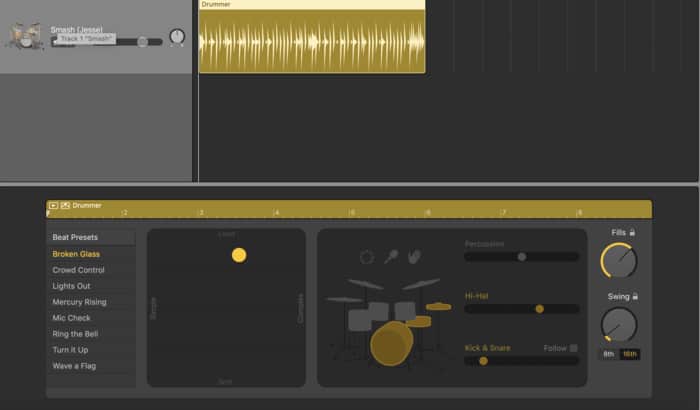Playing guitar with a backing track is great for a number of reasons, including the fact that it’s a lot of fun, and it’s a great way to practice all of the techniques you’ve learned over the years.
How To Play Guitar With A Backing Track
1) Choose your backing track
2) Figure out the song’s key
3) Know the tempo of the song (Optional)
4) Understand what chords are in the song
5) Know what scales and arpeggios work with the track.
6) Play
In this tutorial today, I’m going to run through each one of the above steps in detail, that way you have the best idea possible for how to go about playing with backing tracks.
As I said above, in my opinion, playing along with popular songs and backing tracks is one of the greatest ways to practice, especially when you play in different keys.
1) Choose your backing track
There are a number of resources out there for choosing a backing track. For starters, you can actually subscribe to particular YouTube channels, websites, or even Spotify playlists to get your hands on great music to play over. You can even make your own.
YouTube

Perhaps, the easiest way is to just use a YouTube video. If you open another tab in your browser and go to YouTube, you’ll notice there are a ton of options available on YouTube, from metal backing tracks, jazz backing tracks, pop backing tracks, and so on and so forth.
Elevated Backing Tracks on YouTube is a great channel for discovering very versatile and high-quality backing tracks.
Additionally, the YouTuber, Tom Bailey, has a solid amount of backing tracks.
Jam Track Central is perhaps one of the most popular backing track channels out there, and they have an entire website where you can purchase high-quality backing tracks that appear to be made by some of the best players out there right now, including Andy James among others.
Another thing that you can do is you can download the YouTube videos using YouTube to Mp3 converter, however, it’s important to note that this is for personal use only.
If you want to know how to do this, I recommend you check out the article, How to Sample In Garageband, from my other site, Producer Society. The article walks you through the process of converting songs from YouTube.
However, the issue with this kind of thing is that you don’t own the rights to these backing tracks, so it’s possible you’ll get a copyright strike if you upload a video of yourself playing along to them.
Websites
Jam Track Central has a website where you can find all of their backing tracks, lessons, and guides for learning how to play the guitar, but if you need more instruction on how to do it yourself, I have another guide about that.
Of course, there is a fee for using them, but in my opinion, these online programs are worth it, because when you subscribe, you get access to many different types of immensely useful content.
Additionally, JTC offers tab and standard notation files that go along with the backing tracks. A while ago, I purchased Andy James solos and backing tracks from JTC and it was totally worth it. Although, admittedly, I was never able to play his solos.
Spotify Playlists

I’ve written about this before in other articles. My favourite Spotify Playlist to jam over is Rap Caviar. It’s an unorthodox way of practicing the guitar, but it’s a great way to hone your skills for a number of reasons.
Rap songs tend to be simple, harmonically, with few chord changes, time signature changes, and tempo changes, so they’re great to jam over for fun.
You can also practice your ear; how to figure out the key signature of a song; the accompanying chords; the scales that go with it, and it’s great for your timing. I have to shout out to Travis Barker for this method because he’s the drummer that I got this idea from.
A few years back, he posted a YouTube video of himself jamming along to Soulja Boy’s “Crank That” and it went viral. Since then, a few others have caught on to the practice, including Matt Greiner from August Burns Red.
These guys are drummers, but you can jam over hip-hop songs the same way that drummers do. It’s not limited to rap, however. You can choose any song that you want and play guitar with them, the genre doesn’t matter (Old Town Road is a good example of that and I’ve written about it before).
Make Your Own Backing Tracks
If you have access to a DAW, which I’m sure you do, whether it’s Garageband, Reaper, FL Studio, or so on, you can easily make your own backing tracks.
Garageband, especially, makes this incredibly simple, because of the abilities of the Drummer Track, which is the software program that quickly programs drums for you and sounds great. A lot of people consider the drummer track as one of the best features of the software.

All you have to do is record yourself playing a riff, whether it’s on the guitar or using a MIDI instrument, loop it, and then insert the Drummer Track. If you want to learn how to use the Drummer Track in Garageband, I recommend checking out the following article from Producer Society at this link here.
2) Figure Out The Song’s Key
I already explained how to do this in another article, which you can check out at this link here, however, I’ll quickly do a summary for how I go about doing this.
One way of doing it is just by finding the tonal center of the song. You do this just by listening to it and then playing that note on the instrument. What I do is similar to this, but a bit different.
Essentially, to figure out a song’s key, you just have to be familiar with the Major Scale.
Essentially, what you want to do is memorize how many key signatures there are as well as their names.
Then, you just have to memorize the 7 different mode shapes of the Major Scale (7 including Ionian which is the same as the Major Scale).
And then you can move these shapes all over the neck and quickly figure out a song by comparing the mode shape that works with the song with the Ionian mode.

For instance, if you’re listening to the song, “Bad Guy,” from Billie Eilish, you can start noodling around on your guitar and find just one note that sounds good with the song. From there, you just try out different notes from one of the 7 different mode shapes.
In the case of this song, I started playing the Bb Major scale (Ionian mode) with the track, and I noticed it sounded good, but wasn’t quite right, so then I thought to myself that G Minor was the relative minor of the Bb Major scale, also called Aeolian mode.

So then I played the G Minor (Aeolian mode) and it sounded great, and then I knew the song was in G Minor. Additionally, the first note of the song is G, so that tells you the key signature of the song as well.

Musicians will often tell you that the first note of the song is the key signature or the tonal center of the song, but this isn’t always the case, and for that reason, I don’t like using that method.
However, it’s a great frame of reference, so you could always start out by figuring out what the first note of the song is. If you know the first note, and then you try the corresponding major or minor scale in that position, and it doesn’t work, then go ahead and use my method instead.
3) Know the tempo of the song (optional)
I said this one was optional because it is. You don’t have to figure out the exact tempo of a song in order to jam along to it, it should just come naturally.
However, it’s a good idea to practice figuring out the BPM and time signature of a track because it becomes very useful later when you want to either reconstruct one of your favorite songs in a music production software or if you’re analyzing a piece of music for some other reason.
To figure out the tempo of a song, I typically look at either the Snare drum, the hi-hats, or the Kick. It really depends on the song and the musical style.
For instance, it’s not uncommon for the snare to keep the beat in a metal or rap song, or for the cymbal, ride, or crash.
As I said above, it’s not essential to figure out the exact tempo of the track, however, if you can quickly determine the BPM, it’s only going to give you a better idea of how to play over it, so the additional understanding of the song from another angle is only going to help you play to it even more.
Additionally, you can actually use the website SongBPM, which has a list of tracks with the song’s tempo and key signature. It isn’t always correct, but it’s usually pretty close.
4) Figure Out the Chords of the Song
Once you know what key the song is in, you can start figuring out what chords are employed.
Thankfully, music theory explores what works and why, and so if you’ve determined the key signature of the track, what you can do is just Google Search the chords of that Key Signature and find out what are the chords in that Key Signature.
Mark Sarnecki’s pair of books the Complete Elementary Rudiments and the Answer Book are really what helped me with this. Eventually, you’ll start to just remember the order of chords in the scale, for instance, in the Major Scale, the chords are usually the following.
Chords of the Major Scale
Major, Minor, Minor, Major, Major (Dominant 7th), Minor, Half-Diminished
You might also see them this way:
I, ii, iii, IV, V(7), vi, viiø
Chords of a Minor Key
If the song is in a Minor Key, the chords may be in the following order:
Minor, Half-Diminished, Major, Minor, Minor, Major, Major (Dominant 7th)
i, iiø, III, iv, v, VI, VII(7)
Of course, the song’s chords may or may not follow these guidelines. Music theory is just an explanation of what works and why. It’s not so much a set of rules that people follow.
In other words, if you memorize the order of major and minor triads on a scale, you just have an idea of what the song could be using.
5) Know What Scales and Arpeggios Would Work With the Song
Once you’ve figured out the general progression of the track, you can put arpeggios to good use, for instance, if the song is in Bb Major, the following arpeggios could work with it:
Bb Major, C Minor, D Minor

Eb Major, F7, G minor

and A half-diminished.

Additionally, you can change the voicing of each arpeggio to make it sound a little different, in whatever way you choose.
For instance, you could play a G Minor 9th arpeggio, or a Bb Major 7th arpeggio, or a C Minor 7 arpeggio.
You could play the G Minor Blues scale or the G Minor pentatonic scale, and so on and so forth. It really depends on the song and the structure of it, however.
Popular music songs tend to be less sophisticated because they’re designed to be for the masses. That said, they’re great to learn because they teach you a lot, especially if you’re learning them through JamPlay.
There isn’t a lot of room for the nuance of sophistication, because the more nuanced the track is, the greater the possibility of turning off the listener.
However, on account of popular music’s relative simplicity, it’s easy to jam over.
Jazz and classical music tend to use more complicated chord structures and voicings, so it won’t be quite as simple to jam over.
For instance, Jazz uses the m7b5 chord a lot, as well as the 7b5 chord, or the Diminished 7th. Some of these chords are just harder to play over.
6) Play!
While it seems like a lot of information to take in, it’s really not. You can easily just press play on the backing track and start playing along with it. You don’t need to sit down with a pencil and notebook and jot down all of the possibilities, but you could if you wanted too.
When it comes to improvising over music, especially in front of an audience, it’s challenging to give yourself the freedom to sound not-so-good for a moment.
You might find yourself feeling a little self-conscious and unable to jam the way you normally can. However, with a little bit of practice, you’ll become more comfortable.
YouTube Video Tutorial
Conclusion
I hope this article provided some kind of value to you. Make sure to share it on your social media if it was helpful to you.


 Written By :
Written By :
